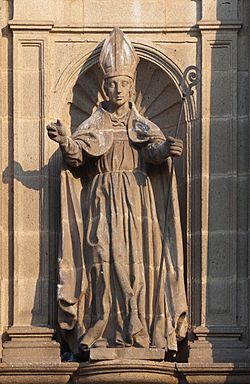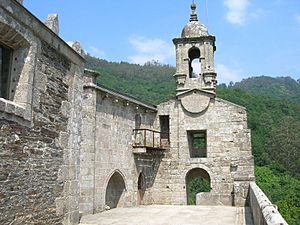Rudesind facts for kids
Quick facts for kids Saint Rudesind |
|
|---|---|

Saint Rudesind, Saint Salvator Monastery, Celanova, Galicia (Spain)
|
|
| Born | November 26, 907 Monte Córdova, Santo Tirso, Portugal (in 907 County of Portucale) Galicia |
| Died | March 1, 977 Celanova |
| Venerated in | Roman Catholic Church Eastern Orthodox Church |
| Canonized | 1195 by Pope Celestine III |
| Major shrine | Celanova Abbey |
| Feast | March 1 |
| Patronage | Pinar del Río, Cuba |
Saint Rudesind (also known as San Rosendo or São Rosendo) was an important leader in Galicia during the 10th century. Born on November 26, 907, he became a bishop and an abbot (the head of a monastery). He also served as a regional governor and a military commander for the Kings of León.
Rudesind came from a powerful noble family. His father was Count Gutierre Menéndez, and his mother was Saint Ilduara Eriz. He was also related to other important religious figures and leaders of his time. Rudesind decided to become a monk when he was very young. By the age of 18, he was already serving as the Bishop of Mondoñedo. He held this important church position from 925 to 950, and again for a short time from 955 to 958.
Contents
Building Monasteries: A Lasting Legacy
Rudesind was known for creating new monasteries, which were places where monks lived and prayed. He followed the rules of Saint Benedict, a famous guide for monastic life.
One of the monasteries he founded was Saint John of Caaveiro in 934. Another very important one was the Monastery of San Salvador de Celanova, which he started on September 12, 936. To build Celanova, Rudesind convinced his brother Fruela and his cousin Jimena to give up their land rights. This allowed him to establish the monastery in a place called Villar.
Rudesind's Role as a Leader and Commander
Rudesind was not just a religious leader; he also played a big part in governing the region and leading armies.
Governing the Land
In 955, King Ordoño III of León appointed Rudesind as the governor of the lands around Celanova. This meant he was in charge of a large area, stretching from Riocaldo in the south of Galicia all the way to Santa Maria de Ortigueira on the coast. Later, from 968 to 969, he was made the governor of all of Galicia.
Leading Against Invaders
Rudesind also led military forces to protect his people. He fought against two different groups of invaders: the Norsemen (also known as Vikings) and the Moors. The Moors had advanced far into the region, reaching the Minho River.
In 966, Norsemen attacked Galicia and killed a local leader and bishop named Sisnand. However, Rudesind gathered the local forces. He led them in battle and defeated the Norse leader, Gunrod.
Later Church Career
Rudesind had already been the Bishop of Mondoñedo. After the death of Bishop Sisnand, Rudesind was given the job of managing the church area of Iria Flavia. He was in charge of this area from 968 to 977. After 977, he decided to retire from his bishop roles.
Rudesind as an Abbot
Rudesind became the abbot of Celanova, taking over from Saint Franquila. As the abbot, he was a very respected figure of his time. Religious leaders from all over Galicia and Portugal would visit him to ask for his spiritual advice. A deacon (a church official) named Egila once wrote to Rudesind, calling him an "eminent bishop, holiest father, true teacher, who teaches your subjects with your words and deeds." Rudesind also became known for performing miracles.
Honoring Saint Rudesind
In 1601, Saint Rudesind's relics (his remains) were carefully removed from their resting place. They were then placed in a silver container at the main altar of the church in Celanova Abbey. This was a way to honor his memory and importance.
A Legend About His Birth
There is a special story about Rudesind's birth. His mother, Ilduara, had lost several children when they were babies. While her husband was away on a trip, Ilduara went alone and barefoot to a small church on Monte Cordova. She prayed there, and it is said that Saint Michael appeared to her. He told her that she would have a son who would become a great leader and a holy man.
To show her thanks, Ilduara ordered a church to be built there. She stayed until Rudesind was born. She wanted to baptize her son at the new church. However, the cart carrying the baptismal font (a large bowl for baptisms) broke down. While workers went to get another cart, Saint Michael supposedly made the broken cart move up the hill by itself.
See also
 In Spanish: Rosendo (santo) para niños
In Spanish: Rosendo (santo) para niños


